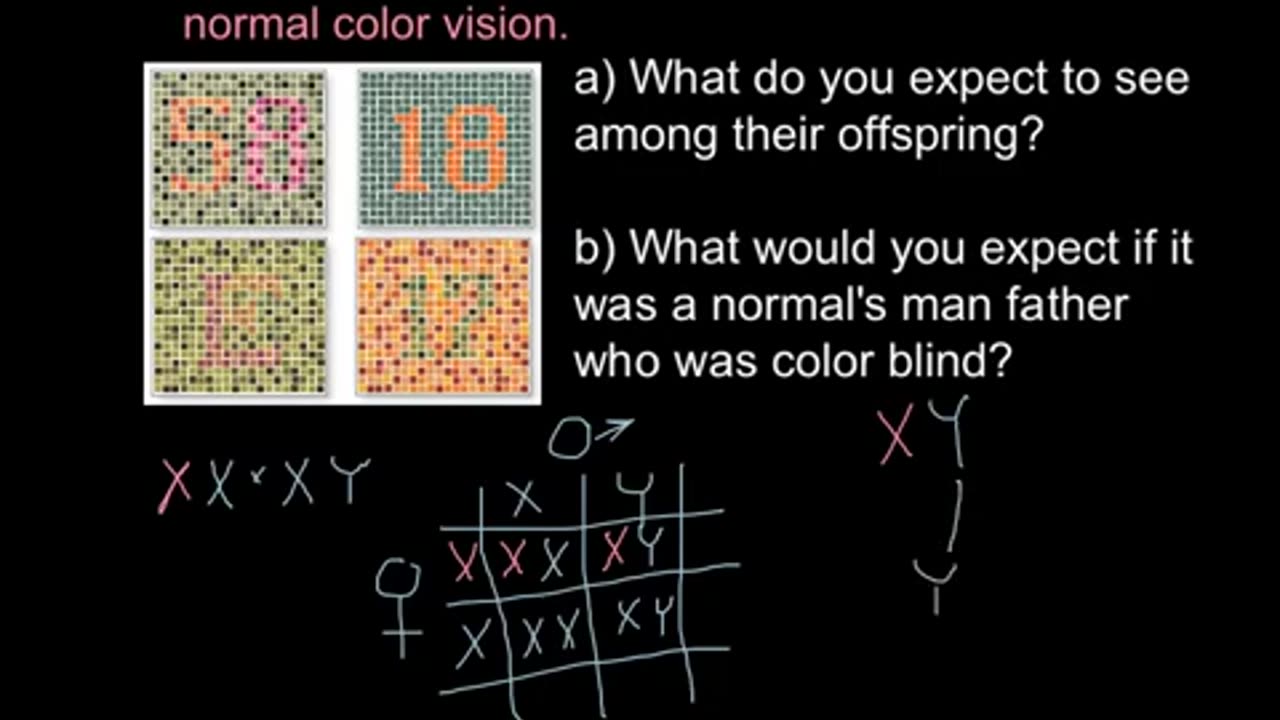Premium Only Content

Color blindness: X chromosome linked inheritance
What is color vision deficiency?
Color vision deficiencies are a group of conditions that affect the perception of color. They cause a range of changes in color vision, from mild difficulty with distinguishing shades to a total inability to detect color. These conditions are divided into three major categories: red-green color vision defects, blue-yellow color vision defects, and a complete absence of color vision.
Red-green color vision defects are the most common form of color vision deficiency. Affected individuals have trouble distinguishing between shades of red and green. They see these colors differently than most people and may have trouble naming different hues. Blue-yellow color vision defects, which are rarer, cause problems with differentiating shades of blue and green. These two forms of color vision deficiency disrupt color perception but do not affect the sharpness of vision (visual acuity).
An absence of color vision, called achromatopsia, is uncommon. People with complete achromatopsia cannot perceive any colors. They see only black, white, and shades of gray. A milder form of this condition, incomplete achromatopsia, may allow some color discrimination. People with achromatopsia almost always have additional problems with vision including reduced visual acuity, increased sensitivity to light (photophobia), and small involuntary eye movements called nystagmus.
How common is color vision deficiency?
Red-green color vision defects are the most common form of color vision deficiency. This condition affects males more often than females. Among populations with Northern European ancestry, it occurs in about 8 percent of males and 0.5 percent of females. Red-green color vision defects have a lower incidence in almost all other populations studied.
Blue-yellow color vision defects affect males and females equally. This condition occurs in fewer than 1 in 10,000 people worldwide.
Complete achromatopsia affects an estimated 1 in 30,000 people. This condition is much more common among Pingelapese islanders, who live on one of the Eastern Caroline Islands of Micronesia. Five percent to 10 percent of this population have a total absence of color vision.
What genes are related to color vision deficiency?
Mutations in the CNGA3, CNGB3, GNAT2, OPN1LW, OPN1MW, and OPN1SW genes cause color vision deficiency.
Changes in the CNGA3, CNGB3, and GNAT2 genes are responsible for achromatopsia. Each of these genes provides instructions for making a protein that is involved in the normal function of cones in the retina. Mutations in any of these genes prevent all three types of cones from reacting appropriately to light. As a result, most people with mutations in one of these genes must depend on rods alone for vision. They typically have no color vision and often have other visual problems as well. Some people with mutations in the CNGA3 gene have incomplete achromatopsia, which may allow some cone function and limited color vision.
A particular form of incomplete achromatopsia, called blue cone monochromacy, occurs when genetic changes prevent both L and M cones from functioning normally. People with this condition have only S cones. Because the brain must compare input from at least two types of cones to detect color, people who have only functional S cones have very poor color vision.
How do people inherit color vision deficiency?
The types of color vision deficiency have different patterns of inheritance. Red-green color vision defects and blue cone monochromacy are inherited in an X-linked recessive pattern. A condition is considered X-linked if the mutated gene that causes the disorder is located on the X chromosome, one of the two sex chromosomes. In males (who have only one X chromosome), one altered copy of the gene in each cell is sufficient to cause the condition. In females (who have two X chromosomes), a mutation must be present in both copies of the gene to cause the disorder. Males are affected by X-linked recessive disorders much more frequently than females. A characteristic of X-linked inheritance is that fathers cannot pass X-linked traits to their sons.
Blue-yellow color vision defects are inherited in an autosomal dominant pattern, which means one copy of the altered OPN1SW gene in each cell is sufficient to cause the condition.
-
 1:19:14
1:19:14
Awaken With JP
2 hours agoEpstein Victim: It Was Definitely a Suicide - LIES Ep 89
54.4K16 -
 LIVE
LIVE
The HotSeat
1 hour agoTrump Wrote History — Democrats Wrote Their Own Obituary in the First 100 Days
620 watching -
 1:44:27
1:44:27
Rebel News
3 hours ago $5.87 earnedElection fallout, Two leaders lose their seats, Canada's future | Rebel Roundup
35K28 -
 LIVE
LIVE
Right Side Broadcasting Network
5 days agoLIVE: President Trump Holds a Rally Celebrating his First 100 Days in Warren, MI - 4/29/25
10,360 watching -
 1:10:39
1:10:39
The Officer Tatum
1 hour agoLIVE Amazon EXPOSED After PROPOSED Tariff Website Feature, Canadian Election + MORE EP 97
12.2K2 -
 1:40:46
1:40:46
Russell Brand
4 hours agoIT’S WAR! Canada Elects GLOBALIST, As PM Vows To “FIGHT” Donald Trump – SF574
139K73 -
 24:25
24:25
Beach Broadcast
4 hours ago4/28/2025 - Big Vatican Comms! Holy See! JA! Trump quote "I run the country and the world"
30.7K18 -
 1:03:04
1:03:04
Timcast
5 hours agoTrump SLAMS Amazon Tariff Pricing, Billionaire WARNS Shortages Coming Ami Economic Collapse
183K152 -
 1:49:55
1:49:55
Steven Crowder
7 hours agoWhy Canada's Election Results Are A Golden Opportunity For Trump, America & Alberta
444K374 -
 46:41
46:41
The White House
5 hours agoPress Secretary Karoline Leavitt Briefs Members of the New Media, Apr. 29, 2025
74.7K24